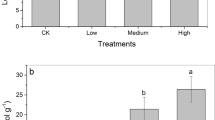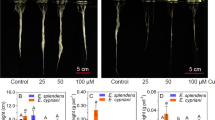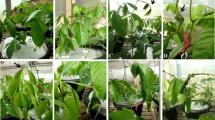Abstract
Rhizophora mucronata is a common mangrove growing in habitats subjected to heavy metal (HM) contamination. Understanding their physiological responses to copper (Cu) and zinc (Zn) excess and underlying tolerance mechanisms is crucial to assess impacts of metal pollution on mangrove community. Seedlings were treated with Cu or Zn (0, 50 or 100 mg per plant) by means of a single addition. At day 3 and 7, Cu and Zn accumulation, photosynthetic efficiency, superoxide dismutase and peroxidase activity, non-protein thiols, reactive oxygen species and lipid peroxidation in roots and leaves were measured. R. mucronata restricted Cu and Zn translocation, thus accumulated HM mainly in roots while kept the leaves unaffected. However, high root HM did not induce oxidative stress nor anti-oxidative defense as HM were largely deposited in cell wall. We concluded that HM tolerance strategies of R. mucronata seedlings are exclusion and restriction of translocation to the vital photosynthetic tissue.





Similar content being viewed by others
References
Alongi DM, Clough BF, Dixon P et al (2003) Nutrient partitioning and storage in arid-zone forests of the mangroves Rhizophora stylosa and Avicennia marina. Trees 17:51–60
Alongi DM, Clough BF, Robertson AI (2005) Nutrient-use efficiency in arid-zone forests of the mangroves Rhizophora stylosa and Avicennia marina. Aquat Bot 82:121–131
Bothe H, Słomka A (2017) Divergent biology of facultative heavy metal plants. J Plant Physiol 219:45–61
Cheng H, Chen DT, Tam NF et al (2012) Interactions among Fe2+, S2–, and Zn2+ tolerance, root anatomy, and radial oxygen loss in mangrove plants. J Exp Bot 63:2619–2630
Colzi I, Doumett S, Bubba MD et al (2011) On the role of the cell wall in the phenomenon of copper tolerance in Silene paradoxa L. Environ Exp Bot 72:77–83
Devi SR, Prasad MNV (1998) Copper toxicity in Ceratophyllum demersum L. (Coontail), a free floating macrophyte: response of antioxidant enzymes and antioxidants. Plant Sci 138:157–165
Elavarthi S, Martin B (2010) Spectrophotometric assays for antioxidant enzymes in plants. In: Sunkar R. (ed) Plant stress tolerance. Methods in molecular biology (methods and protocols), vol 639. Humana, New York
Fritioff A, Kautsky L, Greger M (2005) Influence of temperature and salinity on heavy metal uptake by submersed plants. Environ Pollut 133:265–274
Gonzalez-Mendoza D, Moreno AQ, Zapata-Perez O (2007) Coordinated responses of phytochelatin synthase and metallothionein genes in black mangrove, Avicennia germinans, exposed to cadmium and copper. Aquat Toxicol 83:306–314
Hoppe-Speer SC, Adams JB, Rajkaran A et al (2011) The response of the red mangrove Rhizophora mucronata Lam. to salinity and inundation in South Africa. Aquat Bot 95:71–76
Jambunathan N (2010) Determination and detection of reactiveoxygen species (ROS), lipid peroxidation, and electrolyteleakage in plants. In: Sunkar R (ed) Plant stress tolerance, methods in molecular biology. Humana, New York, pp 291–297
Kaewtubtim P, Meeinkuirt W, Seepom S et al (2016) Heavy metal phytoremediation potential of plant species in a mangrove ecosystem in Pattani Bay, Thailand. Appl Ecol Environ Res 14:367–382
Kamaruzzaman BY, Shuhada NT, Akbar B et al (2011) Spatial concentrations of lead and copper in bottom sediments of Langkawi coastal area, Malaysia. Res J Environ Sci 5:179–186
Kodikara KAS, Jayatiss LP, Huxham M et al (2018) The effects of salinity on growth and survival of mangrove seedlings changes with age. Acta Bot Brasilica 32:37–46
Krzesłowska M (2011) The cell wall in plant cell response to trace metals: polysaccharide remodeling and its role in defense strategy. Acta Physiol Plant 33:35–51
Küpper H, Andresen E (2016) Mechanisms of metal toxicity in plants. Metallomics 8:269–285
Lang I, Wernitznig S (2011) Sequestration at the cell wall and plasma membrane facilitates zinc tolerance in the moss Pohlia drummondii. Environ Exp Bot 74:186–193
Li Y, Zhou C, Huang M et al (2016) Lead tolerance mechanism in Conyza canadensis: subcellular distribution, ultrastructure, antioxidative defense system, and phytochelatins. J Plant Res 129:251–262
Lorestani B, Yousefi N, Cheraghi M et al (2013) Phytoextraction and phytostabilization potential of plants grown in the vicinity of heavy metal-contaminated soils: a case study at an industrial town site. Environ Monit Assess 185:10217–10223
MacFarlane GR, Burchett MD (2000) Cellular distribution of copper, lead and zinc in the grey mangrove. Avicennia marina (Forsk.) Vierh. Aquat Bot 68:45–59
Macfarlane GR, Burchett MD (2001) Photosynthetic pigments and peroxidase activity as indicators of heavy metal stress in the grey mangrove. Avicennia marina (Forsk.) Vierh. Mar Pollut Bull 42:233–240
Macfarlane GR, Burchett MD (2002) Toxicity, growth and accumulation relationships of copper, lead and zinc in the grey mangrove Avicennia marina (Forsk.) Vierh. Mar Environ Res 54:65–84
Macfarlane GR, Koller CE, Blomberg SP (2007) Accumulation and partitioning of heavy metals in mangroves: a synthesis of field-based studies. Chemosphere 69:1454–1464
Monnet F, Vaillant N, Vernay P et al (2001) Relationship between PSII activity, CO2 fixation, and Zn, Mn and Mg contents of Lolium perenne under zinc stress. J Plant Physiol 158:1137–1144
Nanda R, Agrawal V (2016) Elucidation of zinc and copper induced oxidative stress, DNA damage and activation of defence system during seed germination in Cassia angustifolia Vahl. Environ Exp Bot 125:31–41
Phandee S, Buapet P (2018) Photosynthetic and antioxidant responses of the tropical intertidal seagrasses Halophila ovalis and Thalassia hemprichii to moderate and high irradiances. Bot Mar 61:247–256
Printz B, Lutts S, Hausman JF et al (2016) Copper trafficking in plants and its implication on cell wall dynamics. Front Plant Sci 7:1–16
Pumijumnong N (2014) Mangrove forests in Thailand. In: Faridah-Hanum I, Latiff A, Hakeem K, Ozturk M (eds) Mangrove ecosystems of Asia. Springer, New York
Pumijumnong N, Danpradit S (2016) Heavy metal accumulation in sediments and mangrove forest stems from Surat Thani Provice, Thailand. Malays For 79:212–228
Rahman MM, Chongling Y, Rahman MDM et al (2012) Effects of copper on growth, accumulation, antioxidant activity and malondialdehyde content in young seedlings of the mangrove species Kandelia candel (L.). Plant Biosyst 146:47–51
Rattanama K, Pattaratumrong MS, Towatana P, Wongkamhaeng K (2016) Three new records of gammarid amphipod in Songkhla Lake, Thailand. Trop Life Sci Res 27:53–61
Sandilyan S, Kathiresan K (2014) Decline of mangroves—a threat of heavy metal poisoning in Asia. Ocean Coast Manag 102:161–168
Shahid M, Pourrut B, Dumat C et al (2014) Heavy-metal-induced reactive oxygen species: phytotoxicity and physicochemical changes in plants. Rev Environ Contam Toxicol 232:1–44
Silva CAR, Lacerda LD, Rezende CE (1990) Metals reservoir in a red mangrove forest. Biotropica 22:339–345
Singh S, Parihar P, Singh R et al (2016) Heavy metal tolerance in plants: role of transcriptomics, proteomics, metabolomics, and ionomics. Front Plant Sci 6:1143
Souza IC, Rocha LD, Morozesk M et al (2015) Changes in bioaccumulation and translocation patterns between root and leafs of Avicennia schaueriana as adaptive response to different levels of metals in mangrove system. Mar Pollut Bull 94:176–184
Stevens DP, McLaughlin MJ, Heinrich T (2003) Determining toxicity of lead and zinc runoff in soils: salinity effects on metal partitioning and on phytotoxicity. Environ Toxicol Chem 22:3017–3024
Thomas G, Andresen E, Mattusch J et al (2016) Deficiency and toxicity of nanomolar copper in low irradiance—a physiological and metalloproteomic study in the aquatic plant Ceratophyllum demersum. Aquat Toxicol 177:226–236
Yruela I (2009) Copper in plants: acquisition, transport and interactions. Funct Plant Biol 36:409–430
Yruela I, Pueyo JJ, Alonso PJ et al (1996) Photoinhibition of photosystem II from higher plants. J Biol Chem 271:27408–27415
Acknowledgements
This work was supported by Thailand Research Fund (TRF Grant No. MRG6080076). We also thank Asst. Prof. Dr. Siriporn Pradit for technical advice.
Author information
Authors and Affiliations
Corresponding author
Electronic supplementary material
Below is the link to the electronic supplementary material.
128_2019_2589_MOESM1_ESM.tif
Supplementary material 1—Fig. S1 Conceptual diagram showing mechanisms of heavy metal tolerance in Rhizophora mucronata (TIF 180 KB)
Rights and permissions
About this article
Cite this article
Torasa, S., Boonyarat, P., Phongdara, A. et al. Tolerance Mechanisms to Copper and Zinc Excess in Rhizophora mucronata Lam. Seedlings Involve Cell Wall Sequestration and Limited Translocation. Bull Environ Contam Toxicol 102, 573–580 (2019). https://doi.org/10.1007/s00128-019-02589-y
Received:
Accepted:
Published:
Issue Date:
DOI: https://doi.org/10.1007/s00128-019-02589-y




